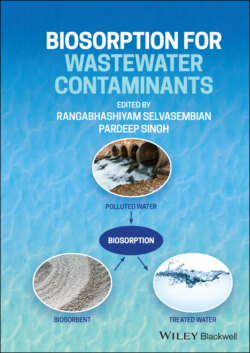Читать книгу Biosorption for Wastewater Contaminants - Группа авторов - Страница 33
Biosorbents Derived from Plant and Animal Waste
ОглавлениеSolid wastes derived from flora and fauna are plentiful, low‐cost, renewable resources. They're made in vast quantities every year, and disposing of them is usually a problem. An important area of research is to find meaningful uses for these materials. They can be used to minimize waste and create cost‐effective products (Kulkarni, 2014).
Plants disposed of as agricultural waste and food industry waste can be used as biosorbents. This is a method of repurposing and recycling discarded materials, so using plant materials has no significant cost (Ali Redha, 2020). Plant‐derived wastes are predominantly made up of cellulose, with structural components such as lignin, proteins, hemicellulose, carbohydrates, lipids, and starch (Rajapaksha et al., 2015). Plant biosorbents can absorb water because of the presence of carboxylic and phenolic functional groups in the cellulosic matrix and components linked with cellulose, such as hemicellulose and lignin (Abdi and Kazemi, 2015). Based on cation exchange between binding sites and metal ions, the metal ions bind with functional groups, resulting in biosorption and, therefore, the removal of the metal ions from media (Abdi and Kazemi, 2015). Table 2.5 lists the various plants employed as biosorbents.
Table 2.4 Biosorption of heavy metals by different yeasts.
| Yeast biomass(biosorbent) | Metal ions(biosorbate) | References |
|---|---|---|
| Candida utilis | Chromium | (Anaemene, 2012) |
| Saccharomyces cerevisiae | Cadmium | (Das et al., 2008) |
| Saccharomyces cerevisiae | Cobalt | (Arakaki et al., 2011) |
| Candida pelliculosa | Copper | (Apinthanapong and Phensaijai, 2009) |
| Mucor rouxii | Lead | (Muraleedharan et al., 1991) |
| Saccharomyces cerevisiae | Mercury | (Anaemene, 2012) |
| Saccharomyces cerevisiae | Nickel | (Siñeriz et al., 2009) |
| Thiobacillusthiooxidans | Zinc | (Nagashetti et al., 2013) |
Table 2.5 Biosorption of heavy metals by different plant materials.
| Plant waste | Metal | Adsorption capacity | Reference |
|---|---|---|---|
| Wheat bran | Mercury | 82% | (Farajzadeh and Monji, 2004) |
| Black gram husk | Lead | 93% | (Saeed et al., 2005) |
| Rice bran | Cadmium | 80% | (Montanher et al., 2005) |
| Baggase | Zinc | 90–95% | (Mohan and Singh, 2002) |
| Activated carbon of peanut shells | Nickel | 75% | (Wilson et al., 2006) |
| Barley straw | Copper | 80% | (Pehlivan et al., 2012) |
| Coconut shell fibers | Chromium | 80% | (Mohan et al., 2006) |
Animal waste products are dumped as solid waste in the environment without being processed or composted or simply washed into water canals, posing a health risk to humans and other living species. The chance to use animal waste for a useful purpose is lost if they are discarded without preparation. Some research has looked into using these animal waste products as a viable adsorbent to adsorb heavy metals from effluent because they are inexpensive and conveniently accessible. Heavy metal adsorption has been researched using animal manure as an adsorbent. Animal bones, pretreated fish bones, crab shells, pretreated arca shells, pretreated crab and arca shells, eggshells, Muscadomestica, and so on are a few other examples (Srivastava et al., 2016). Table 2.6 summarizes the results of the adsorption analysis performed on animal byproducts.
Table 2.6 Biosorption of heavy metals by different animal wastes.
| Animal waste | Metal | Adsorption capacity | Reference |
|---|---|---|---|
| Pretreated fish bones | Copper | 150.7 mg/g. | (Kizilkaya et al., 2010) |
| Dried animal bones | Zinc | 0.1764 mmol/g. | (Banat et al., 2002) |
| Crab shell | Cobalt | 322.6 mg/g | (Vijayaraghavan et al., 2006) |
| Pretreated arca shell biomass | Lead | 18.33 mg/g | (Dahiya et al., 2008) |
| Animal bone | Nickel | 7.22 mg/g | (Al‐Asheh et al., 1999) |
These adsorbents could offer significant advantages compared to currently available economically priced activated carbons and help with waste reduction. Furthermore, research is required to adapt the simulation methodology to larger manufacturing facilities rather than small experimental applications.
